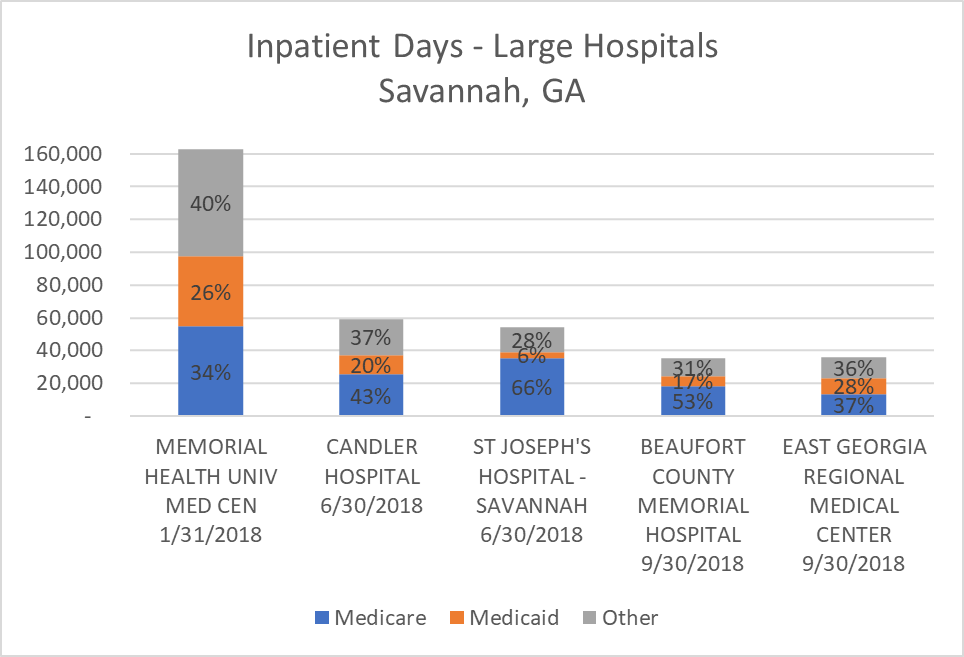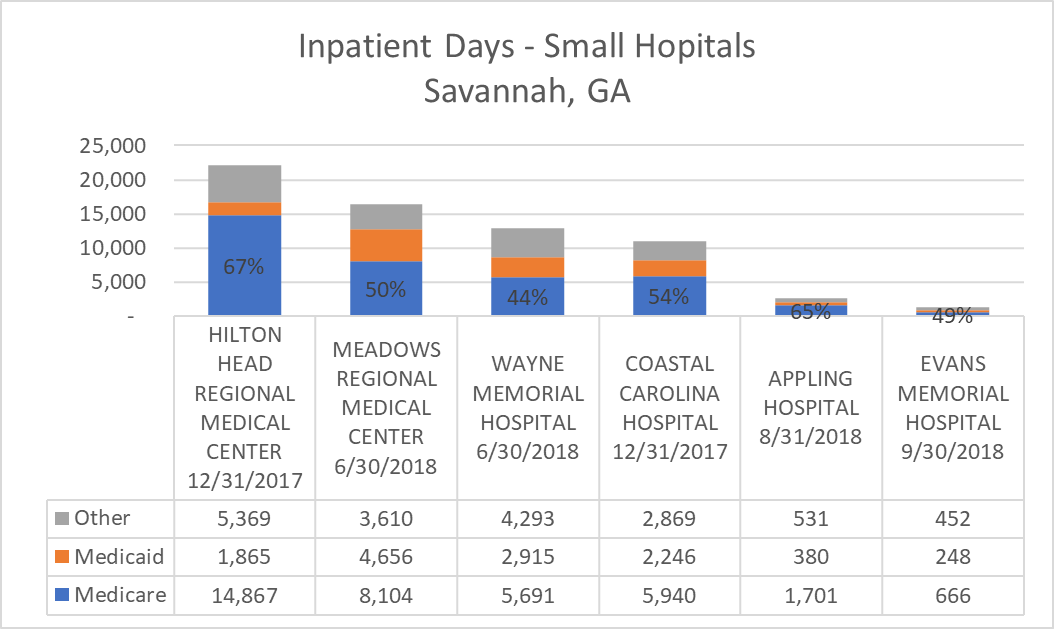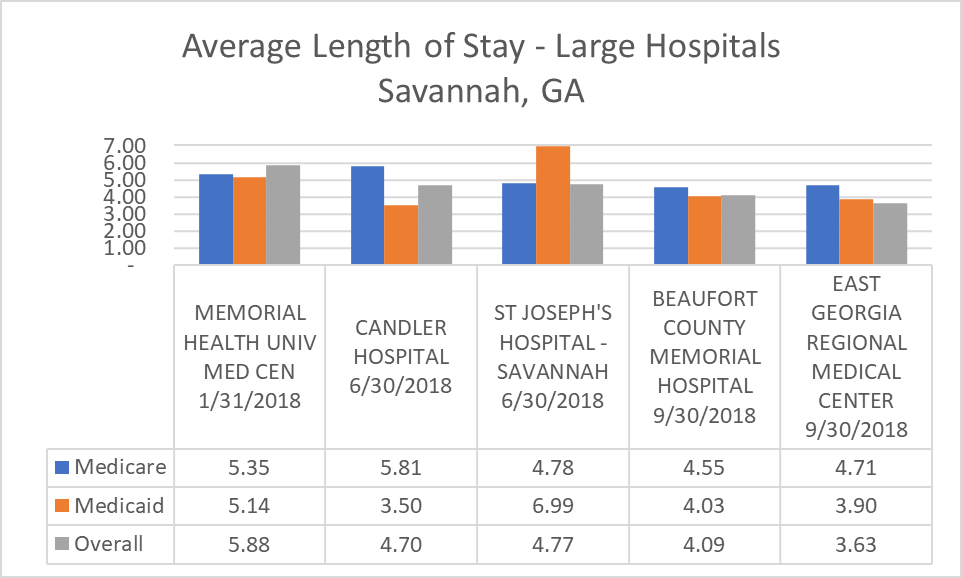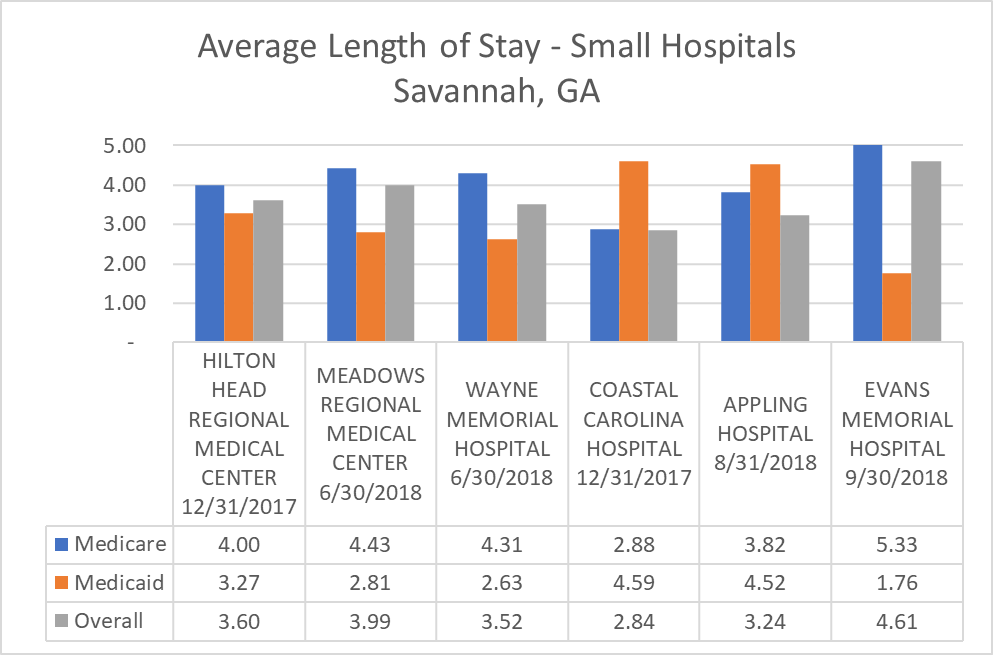Savannah, Georgia Area: Beds, Inpatient Days, and Average Length of Stay
In this post, we’ll cover some of that data that is found on the Medicare Cost Report on Worksheet S-3, Part I. This data will shed some light on the size of the hospitals (bed count), bed utilization (how often there are heads in a bed), the makeup of the patients (Medicare or Medicaid), and how long the patients stay in the hospital (average length of stay).
To me, it’s interesting to see the size of the hospitals. Fortunately, I don’t spend a lot of time in hospitals, so I don’t have first hand knowledge of their size. So far in this short blog journey, I’ve been impressed with just how large of a medical community these cities have. It takes a lot to keep our society well, apparently.
So, let’s take a journey together through the beautiful, historic city of Savannah, Georgia and their hospital community.
Beds in Service
One indicator of size for a hospital is how many beds are in service. If you look at a hospital’s website, they are most likely going to report licensed beds. On the cost report, though, they report how many beds are actually staffed versus how many they are licensed to operate.
| Hospital | Beds in Service |
|---|---|
| MEMORIAL HEALTH UNIV MED CEN, INC | 517 |
| CANDLER HOSPITAL | 212 |
| ST JOSEPH’S HOSPITAL - SAVANNAH | 210 |
| BEAUFORT COUNTY MEMORIAL HOSPITAL | 167 |
| EAST GEORGIA REGIONAL MEDICAL CENTER | 142 |
| HILTON HEAD REGIONAL MEDICAL CENTER | 93 |
| WAYNE MEMORIAL HOSPITAL | 88 |
| MEADOWS REGIONAL MEDICAL CENTER | 52 |
| EVANS MEMORIAL HOSPITAL | 49 |
| COASTAL CAROLINA HOSPITAL | 41 |
| APPLING HOSPITAL | 34 |
Based on the table above, there are 5 large hospitals: Memorial Health, Candler, St Joseph’s, Beaufort County, and East Georgia Regional. In general, hospitals over 100 beds are large. Well, it may be better said that hospitals under 100 beds are treated differently because of their bed size.
Bed Utilization
The question with bed utilization is how often are there heads in a bed? A hospital is required to have a certain number of staff. A hospital starts struggling seriously when staff is standing around with nothing to do.
| Hospital | Inpatient Days | Nursery Days | Bed Utilization |
|---|---|---|---|
| MEMORIAL HEALTH UNIV MED CEN | 162,702 | 0 | 78% |
| CANDLER HOSPITAL | 59,319 | 8,307 | 66% |
| ST JOSEPH’S HOSPITAL - SAVANNAH | 53,970 | 6 | 70% |
| BEAUFORT COUNTY MEMORIAL HOSPITAL | 35,148 | 1,916 | 55% |
| EAST GEORGIA REGIONAL MEDICAL CENTER | 35,978 | 3,575 | 63% |
| HILTON HEAD REGIONAL MEDICAL CENTER | 22,101 | 866 | 63% |
| WAYNE MEMORIAL HOSPITAL | 12,899 | 1,212 | 36% |
| MEADOWS REGIONAL MEDICAL CENTER | 16,370 | 1,491 | 78% |
| EVANS MEMORIAL HOSPITAL | 1,366 | 0 | 8% |
| COASTAL CAROLINA HOSPITAL | 11,055 | 1,316 | 65% |
| APPLING HOSPITAL | 2,612 | 0 | 21% |
I show nursery days as nursery beds are not in the inpatient bed count reported on the cost report. At the larger hospitals, they are likely to have an OB unit, and if so, they should have nursery days reported. If they don’t show any nursery days, then there is a possibility that the utilization is overstated as nursery days may be included with adults & peds.
For the most part, these hospitals are really busy. For the smaller hospitals with low utilization, they could be using these beds as swing beds. Swing beds can be used to provide skilled nursing services, which is a lower level of care than acute. For this blog, I am focusing on acute, hoping to not get too deep in the weeds.
Medicare and Medicaid Day Utilization
On the cost report, the hospital will report Medicare days, Medicaid days and Total days. This information is for Inpatients only. For Medicare days, if a patient also has Medicaid, their days will not be included in the Medicaid data. Medicaid days are just patients with only Medicaid or Medicaid secondary to a commercial insurance.

Memorial Health has a decent amount of Medicaid, which is consistent with them being a children’s hospital and having a Level I trauma unit.
St Joseph has a much higher Medicare population and my guess is this is due to them performing a good bit of orthopedic surgeries and cardiovascular care.
East Georgia Regional has a good share of Medicaid as well. If I had to guess, I’d say the census data will confirm a lower average wage for this area. I may be wrong, so it will be a learning opportunity for me.

Hilton Head Regional has a high percentage of Medicare. Per their website, it looks like cardiovascular care and orthopedics are some of their specialties. I don’t know much about the population age in Hilton Head Island, SC, so I wonder if they have a large retiree population.
Meadows Regional has a higher Medicaid population than the rest. I wonder if the census data will shed some light on this hospital in Vidalia, Georgia. Perhaps they have a higher poverty rate or maybe a lower median wage. Those are my guesses for now.
Average Length of Stay
Let’s take a look at how long patients are in-house at these hospitals on average. These are short-term acute care hospitals, so I expect the average lengths of stay (ALOS) will be low.

I want to note some data outliers. Memorial Health reported no nursery days and St Joseph reported 6. I bring this up because nursery discharges are not reported on the cost report. If nursery days are included and discharges are not, then the data is not in alignment.
With that being said, Medicaid ALOS looks really high at St Joseph’s. Not sure if it’s an outlier or issue with reporting days with no discharges. Who knows? I did expect a higher ALOS at Memorial Health since they have a trauma unit, so that looks reasonable.

I’m going to go out on a limb and say something is awry with Evans Memorial’s Medicaid ALOS. Most patients aren’t admitted unless the physician thinks they will be there at least two nights. The rest of the figures look uneventful; what I would expect to see.
Musing Revelation
Looking at the volumes at these hospitals, I am pleasantly surprised at the amount of business this medical community has. This should bode well for the economy in these areas.
I’m starting to think older patients frequent hospitals more. I’ve never really thought about it, which is why I’m surprised at the percentage of the Medicare populations at these hospitals. I’m learning something new for sure.
This covers a good portion of Worksheet S-3, Part I on the Medicare Cost Report. All of this data is subject to change at any given time for any number of reasons. My only goal is to look through what is reported to learn more about these hospitals. Hopefully, somewhere along the line you will learn something too.
